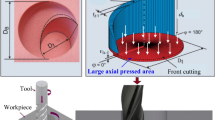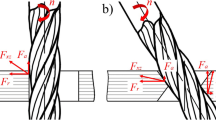Abstract
Laminates of carbon fibre reinforced polymer (CFRP) and titanium (Ti) alloy are used in aerospace applications and require holes for joining to other components, which can weaken them. In this study, to determine the influences of drilling and helical milling on the geometric accuracy of holes, holes were made in a CFRP/Ti-laminated structure by these two techniques, and variations in aperture and roundness at different positions were investigated. In two processes, apertures are larger in the middle and smaller at the ends, and most are larger than the apertures of standard holes (6 mm). With drilling, roundness is relatively high at hole entrances and exits. In helical milling, the maximum roundness occurs just underneath the hole entrance, while the minimum occurs at the exit. In the drilling of Ti alloy, the maximum aperture occurs at the entrance; however, with helical milling, the hole entrance aperture is smaller. The aperture at other positions is relatively small. During drilling, the maximum roundness occurs at hole entrances, while the minimum occurs just underneath and then increases with depth. Helical milling produces a relatively large roundness at hole entrances, with consistent variation in other positions. Generally, helical milling of a laminated structure produces better geometric accuracy in holes in the Ti alloy layer, better hole roundness in the CFRP layer, and smaller roundness in the transition zone. However, drilling achieves better aperture accuracy in CFRP and smaller aperture errors in the transition zone. These results will help to produce stronger CFRP/Ti-laminated structures.










Similar content being viewed by others
Data availability
Not applicable (secret information)
References
Soutis C (2005) Fibre reinforced composites in aircraft construction. Prog Aerosp Sci 41:143–151
Geng D, Liu Y, Shao Z, Lu Z, Cai J, Li X, Jiang X, Zhang D (2019) Delamination formation, evaluation and suppression during drilling of composite laminates: a review. Compos Struct 216:168–186
Park K, Beal A, Kwon P, Kim DD, Jeff L (2011) Tool wear in drilling of composite/titanium stacks using carbide and polycrystalline diamond tools. Wear 271:2826–2835
Wang H, Qin X, Li H, Tan Y (2016) A comparative study on helical milling of CFRP/Ti stacks and its individual layers. Int J Adv Manuf Technol 86:1973–1983
Eynian M, Das K, Wretland A (2017) Effect of tool wear on quality in drilling of titanium alloy Ti6Al4V, part I: cutting forces, burr formation, surface quality and defects. High Speed Mach 3:1–10
Wang B, Gao H, Bi M, Zhuang Y (2012) Mechanism of reduction of damage during orbital drilling of C/E composites. J Mech Eng 48:173–181
Zhou L, Ke Y, Dong H, Chen Z, Gao K (2016) Hole diameter variation and roundness in dry orbital drilling of CFRP/Ti stacks. Int J Adv Manuf Technol 87:811–824
Denkena B, Boehnke D, Dege JH (2008) Helical milling of CFRP–titanium layer compounds. CIRP J Manuf Sci Technol 1:64–69
Liu S, Xia W, Wang N, Liu Y, Ye Z (2019) Research on thrust force and hole quality of drilling CFRP/Ti stacks in low temperature. Aeronaut Manuf Technol 62:82–86
Li H, He G, Qin X, Wang G, Lu C, Gui L (2014) Tool wear and hole quality investigation in dry helical milling of Ti-6Al-4V alloy. Int J Adv Manuf Technol 71:1511–1523
Prisco U, Impero F, Rubino F (2019) Peck drilling of CFRP/titanium stacks: effect of tool wear on hole dimensional and geometrical accuracy. Prod Eng 13:529–538
Yu S, Qin X, Li S, Wu Q, Liu Z, Zhang X (2017) Comparison study on machining property of drilling tools for CFRP/titanium alloy laminated structures. Mech Sci Technol Aerosp Eng 36:1641–1645
Nan C, Wu D, Ma X, Chen K (2016) Study on the drilling quality of carbon fiber reinforced plastic and titanium stacks. J Mech Eng 52:177–185
Dong Z, Gao Y, Kang R, Yang G, Bao Y (2020) Research on hole diameter deviation in helical milling of titanium alloy. Acta Aeronautica et Astronautica Sinica. https://doi.org/10.7527/S1000-6893.2020.23841
Tian Y, Liu Y, Wang F, Jing X, Zhang D, Liu X (2017) Modeling and analyses of helical milling process. Int J Adv Manuf Technol 90:1003–1022
Li S, Tian L, Qin X, Zhang X, Zhang H, Li Y (2017) Diameter error compensation based on flexible cutting force model in hole helical milling process. J Tianjin Univ (Science and Technology) 50:147–153
Kline WA, DeVor RE, Shareef IA (1982) The prediction of surface accuracy in end milling. J Eng Ind 104:272–278
Pereira RBD, Brandão LC, de Paiva AP, Ferreira JR, Davim JP (2017) A review of helical milling process. Int J Mach Tools Manuf 120:27–48
Davim JP (2013) Machining composites materials. John Wiley & Sons, Hoboken
Davim JP, Rubio J, Abrao A (2007) A novel approach based on digital image analysis to evaluate the delamination factor after drilling composite laminates. Compos Sci Technol 67(9):1939–1945
Campos RJ, Abrao AM, Faria PE, Correia AE, Davim JP (2008) Effects of high speed in the drilling of glass fibre reinforced plastic: evaluation of the delamination factor. Int J Mach Tools Manuf 48(6):715–720
Abrão AM, Rubio JCC, Faria PE, Davim JP (2008) The effect of cutting tool geometry on thrust force and delamination when drilling glass fibre reinforced plastic composite. Mater Des 29(2):508–513
Gaitonde VN, Karnik SR, Rubio JC, Correia AE, Abrão AM, Davim JP (2008) Analysis of parametric influence on delamination in high-speed drilling of carbon fiber reinforced plastic composites. J Mater Process Technol 203(1–3):431–438
Wang B, Gao H, Cao B, Zhuang Y, Zhao Z (2014) Mechanism of damage generation during drilling of carbon/epoxy composites and titanium alloy stacks. Proc Inst Mech Eng B J Eng Manuf 228(7):698–706
Wang B, Wang Y, Zhao H, Sun L, Wang M, Kong X (2020) Effect of a Ti alloy layer on CFRP hole quality during helical milling of CFRP/Ti laminate. Compos Struct 252:112670
Chen M, Xu J, An Q (2019) Cutting theory and application technology of carbon fiber composite material and laminated structure. Shanghai Scientific & Technical Publishers, Shanghai
Xu J (2017) The research on helical milling experiments of C/E composites. Dissertation, Dalian University of Technology
Brinksmeier E, Janssen R (2002) Drilling of multi-layer composite materials consisting of carbon fiber reinforced plastics (CFRP), titanium and aluminum alloys. CIRP Ann 51:87–90
Funding
This study was financially supported by the National Natural Science Foundation of China (NSFC) (Grant NOs. 51875367, 51505302), Natural Science Foundation of Liaoning Province (Grant No. 2020-MS-234), Foundation of Liaoning Educational Committee (Grant No. JYT2020004), China Postdoctoral Science Foundation (Grant No. 2020M670790) and Shenyang Youth Science and technology innovation project (Grant No. RC190072).
Author information
Authors and Affiliations
Contributions
Ben Wang: conceptualization, methodology, and writing—review and editing
Hua Zhao: formal analysis and writing—original draft
Fan Zhang: investigation
Minghai Wang: supervision
Yaohui Zheng: validation
Corresponding author
Ethics declarations
Competing interests
The authors declare that they have no known competing financial interests or personal relationships that could have appeared to influence the work reported in this paper.
Additional information
Publisher’s note
Springer Nature remains neutral with regard to jurisdictional claims in published maps and institutional affiliations.
Rights and permissions
About this article
Cite this article
Wang, B., Zhao, H., Zhang, F. et al. Comparison of the geometric accuracy of holes made in CFRP/Ti laminate by drilling and helical milling. Int J Adv Manuf Technol 112, 3343–3350 (2021). https://doi.org/10.1007/s00170-021-06594-6
Received:
Accepted:
Published:
Issue Date:
DOI: https://doi.org/10.1007/s00170-021-06594-6




